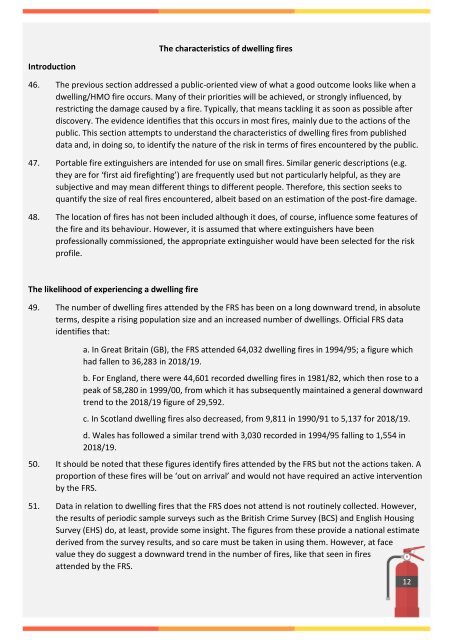An evaluation of the role of fire extinguishers
A report considering the role of a fire extinguisher in human terms identifying the gap between policy assumptions and the evidence from real fires. It considers the implications arising from this and makes a number of recommendations to create an evidence base and enhance current fire safety policies/advice.
A report considering the role of a fire extinguisher in human terms identifying the gap between policy assumptions and the evidence from real fires. It considers the implications arising from this and makes a number of recommendations to create an evidence base and enhance current fire safety policies/advice.
You also want an ePaper? Increase the reach of your titles
YUMPU automatically turns print PDFs into web optimized ePapers that Google loves.
The characteristics <strong>of</strong> dwelling <strong>fire</strong>s<br />
Introduction<br />
46. The previous section addressed a public-oriented view <strong>of</strong> what a good outcome looks like when a<br />
dwelling/HMO <strong>fire</strong> occurs. Many <strong>of</strong> <strong>the</strong>ir priorities will be achieved, or strongly influenced, by<br />
restricting <strong>the</strong> damage caused by a <strong>fire</strong>. Typically, that means tackling it as soon as possible after<br />
discovery. The evidence identifies that this occurs in most <strong>fire</strong>s, mainly due to <strong>the</strong> actions <strong>of</strong> <strong>the</strong><br />
public. This section attempts to understand <strong>the</strong> characteristics <strong>of</strong> dwelling <strong>fire</strong>s from published<br />
data and, in doing so, to identify <strong>the</strong> nature <strong>of</strong> <strong>the</strong> risk in terms <strong>of</strong> <strong>fire</strong>s encountered by <strong>the</strong> public.<br />
47. Portable <strong>fire</strong> <strong>extinguishers</strong> are intended for use on small <strong>fire</strong>s. Similar generic descriptions (e.g.<br />
<strong>the</strong>y are for ‘first aid <strong>fire</strong>fighting’) are frequently used but not particularly helpful, as <strong>the</strong>y are<br />
subjective and may mean different things to different people. Therefore, this section seeks to<br />
quantify <strong>the</strong> size <strong>of</strong> real <strong>fire</strong>s encountered, albeit based on an estimation <strong>of</strong> <strong>the</strong> post-<strong>fire</strong> damage.<br />
48. The location <strong>of</strong> <strong>fire</strong>s has not been included although it does, <strong>of</strong> course, influence some features <strong>of</strong><br />
<strong>the</strong> <strong>fire</strong> and its behaviour. However, it is assumed that where <strong>extinguishers</strong> have been<br />
pr<strong>of</strong>essionally commissioned, <strong>the</strong> appropriate extinguisher would have been selected for <strong>the</strong> risk<br />
pr<strong>of</strong>ile.<br />
The likelihood <strong>of</strong> experiencing a dwelling <strong>fire</strong><br />
49. The number <strong>of</strong> dwelling <strong>fire</strong>s attended by <strong>the</strong> FRS has been on a long downward trend, in absolute<br />
terms, despite a rising population size and an increased number <strong>of</strong> dwellings. Official FRS data<br />
identifies that:<br />
a. In Great Britain (GB), <strong>the</strong> FRS attended 64,032 dwelling <strong>fire</strong>s in 1994/95; a figure which<br />
had fallen to 36,283 in 2018/19.<br />
b. For England, <strong>the</strong>re were 44,601 recorded dwelling <strong>fire</strong>s in 1981/82, which <strong>the</strong>n rose to a<br />
peak <strong>of</strong> 58,280 in 1999/00, from which it has subsequently maintained a general downward<br />
trend to <strong>the</strong> 2018/19 figure <strong>of</strong> 29,592.<br />
c. In Scotland dwelling <strong>fire</strong>s also decreased, from 9,811 in 1990/91 to 5,137 for 2018/19.<br />
d. Wales has followed a similar trend with 3,030 recorded in 1994/95 falling to 1,554 in<br />
2018/19.<br />
50. It should be noted that <strong>the</strong>se figures identify <strong>fire</strong>s attended by <strong>the</strong> FRS but not <strong>the</strong> actions taken. A<br />
proportion <strong>of</strong> <strong>the</strong>se <strong>fire</strong>s will be ‘out on arrival’ and would not have required an active intervention<br />
by <strong>the</strong> FRS.<br />
51. Data in relation to dwelling <strong>fire</strong>s that <strong>the</strong> FRS does not attend is not routinely collected. However,<br />
<strong>the</strong> results <strong>of</strong> periodic sample surveys such as <strong>the</strong> British Crime Survey (BCS) and English Housing<br />
Survey (EHS) do, at least, provide some insight. The figures from <strong>the</strong>se provide a national estimate<br />
derived from <strong>the</strong> survey results, and so care must be taken in using <strong>the</strong>m. However, at face<br />
value <strong>the</strong>y do suggest a downward trend in <strong>the</strong> number <strong>of</strong> <strong>fire</strong>s, like that seen in <strong>fire</strong>s<br />
attended by <strong>the</strong> FRS.<br />
12




